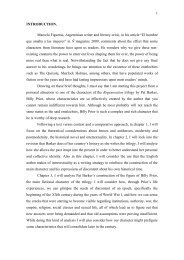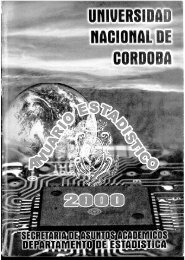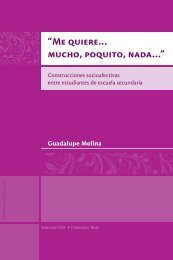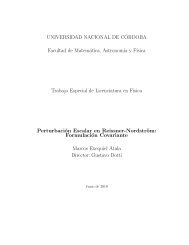Abrir - RDU - Universidad Nacional de Córdoba
Abrir - RDU - Universidad Nacional de Córdoba
Abrir - RDU - Universidad Nacional de Córdoba
Create successful ePaper yourself
Turn your PDF publications into a flip-book with our unique Google optimized e-Paper software.
5.3. DETERMINACIÓN DE SUBGRUPOS CUÁNTICOS FINITOS 87<br />
Finalmente, si h ∈ Ker Res, entonces 0 = π L Res(h) = rπ(h) = ˆπq(h). Esto implica que q(h) ∈<br />
Ker ˆπ = (C Γ ) + A = q(O(G) + O ɛ (G)). Entonces existen a ∈ O(G) + O ɛ (G) y c ∈ Ker q tales que<br />
h = a + c; en particular, para todo generador t <strong>de</strong> I tenemos que t = µ ɛ (a) + µ ɛ (c), don<strong>de</strong> µ ɛ (a)<br />
está contenido en A 0 . Comparando grados en ambos lados <strong>de</strong> la igualdad se sigue que µ ɛ (a) = 0, lo<br />
cual implica que cada generador <strong>de</strong> I está en µ ɛ (Ker q).<br />
El siguiente lema muestra la conveniencia <strong>de</strong> caracterizar a los cocientes A ɛ,l,σ <strong>de</strong> O ɛ (G) <strong>de</strong><br />
dimensión finita como pushout.<br />
Lema 5.3.3. σ(Γ) ⊆ L y por lo tanto A es un cociente <strong>de</strong>l álgebra <strong>de</strong> Hopf A ɛ,l,σ dada por el<br />
pushout. Más aún, el siguiente diagrama conmuta<br />
1 O(G)<br />
ι<br />
O ɛ (G)<br />
π<br />
u ɛ (g) ∗<br />
1<br />
res<br />
1 O(L)<br />
ι L<br />
Res<br />
O ɛ (L)<br />
π L<br />
P<br />
u ɛ (l) ∗ 1<br />
1 <br />
u<br />
C Γ<br />
j<br />
s<br />
¯π<br />
A ɛ,l,σ u ɛ (l) ∗<br />
1<br />
1 <br />
C Γ ˆι A<br />
t<br />
v<br />
ˆπ H 1.<br />
Demostración. Por el lema anterior tenemos que wι L<br />
conmuta<br />
ι L<br />
O(L) O ɛ (L)<br />
= ˆιu, es <strong>de</strong>cir, el siguiente diagrama<br />
u<br />
C Γ<br />
j<br />
s<br />
w<br />
A ɛ,l,σ<br />
A.<br />
ˆι<br />
Como A ɛ,l,σ es un pushout, existe un único morfismo <strong>de</strong> álgebras <strong>de</strong> Hopf t : A ɛ,l,σ → A tal que<br />
ts = w y tj = ˆι. Esto implica que Ker ¯π = j(C Γ ) + A ɛ,l,σ ⊆ Ker ˆπt y por lo tanto el siguiente diagrama<br />
<strong>de</strong> sucesiones exactas <strong>de</strong> álgebras <strong>de</strong> Hopf es conmutativo<br />
1 <br />
C Γ<br />
j<br />
A ¯π ɛ,l,σ u ɛ (l) ∗<br />
1<br />
1 <br />
C Γ ˆι A<br />
t<br />
v<br />
ˆπ H 1.<br />
Sea (Σ, I + , I − ) la terna que <strong>de</strong>termina H y s = n − |I + ∪ −I − |. Recor<strong>de</strong>mos que, por la Observación<br />
5.2.11, dar un grupo Σ tal que (Z/(l)) n−s ⊆ Σ ⊆ (Z/(l)) n es lo mismo que dar un<br />
subgrupo N ⊆ (Z/(l)) s . De hecho, por el tercer paso <strong>de</strong> la construcción dada en la sección anterior,<br />
sabemos que el álgebra <strong>de</strong> Hopf A ɛ,l,σ contiene un conjunto <strong>de</strong> elementos centrales <strong>de</strong> tipo grupo
















